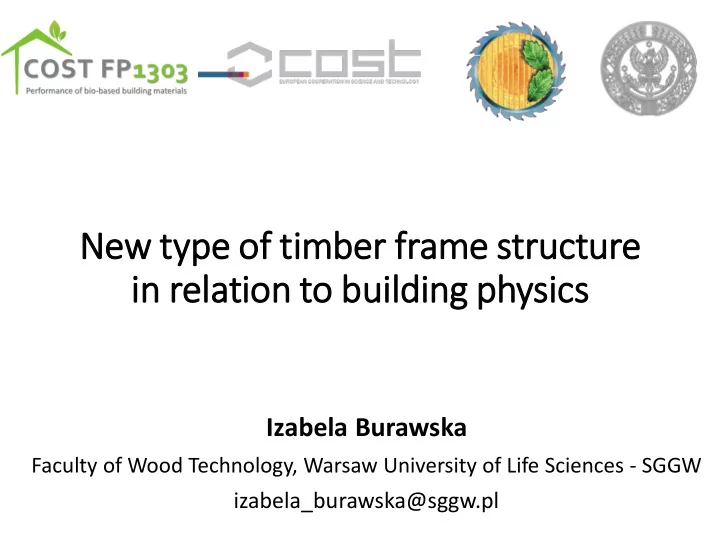

New typ type of of ti timber fr frame structure in in rela lation to o buil ilding physics Izabela Burawska Faculty of Wood Technology, Warsaw University of Life Sciences - SGGW izabela_burawska@sggw.pl
In Introduction Polish construction industry: - increase in popularity of timber structures due to growing awereness of the benefits ✓ Fast, efficient and cost effective construction ✓ Flexible to add further extensions ✓ Environmentally friendly ✓ Unique character ✓ Lower self-weight of the structure – possibility to use smaller cross sections ✓ Larger usable space compared to the same building in for example brick technology
In Introduction Described project concerns the development of new structural elements of timber frame buildings. Walls, ceilings and roof truss with new, glued spatially elements were developed, as well as the connections in the corners with half logs. The scope of work includes the building physics -analysis of issues of temperature and humidity in barriers was performed.
Tech chnology - Timber frame structure, made of natural materials - The main structural element – spatially glued half log and columns - Utilization of small sized softwood, which was used before only as a firewood - In typical production technology 30 % of material is a waste
Tech chnology - Typically used OSB was replaced with cement bonded particleboard as a stiffening - The main insulating material is a mineral wool
Buid iding physics - Termo-URSA software - Heat transfer coefficient U was determined in case of external walls and roof - The condensation takes place when the actual pressure of water vapour is higher than the saturated vapour pressure in the adopted conditions - The current value of U coefficient for external walls is 0.25 W/m2K, from January 2017 it will be 0.23 W / m2K, and from January 2021 - 0.20 W/m2K. Similar for roofs – currently U coefficient is 0.20 W/m2K, from January 2017 it will be 0.18 W/m2K, and from January 2021 – 0.15 W/m2K.
Buid iding physics During the analysis it was assumed that air gap is ventilated. With respect to condensation conditions in the outer wall, effective value of the temperature coefficient at the inner surface of the barrier (fRs) was determined on the basis of the heat transfer coefficient and the heat transfer resistance at the inner surface.
Buid iding physics Technical parameters for walls and roof meet the requirements of the standard. The heat transfer coefficient meets the requirements of current standard and even complies with the requirements to be introduced in 2021. Obtained results allow to define the developed structure as a passive.
Thank you for your kind attention! izabela_burawska@sggw.pl Faculty of Wood Technology, Warsaw Universty of Life Sciences - SGGW
Recommend
More recommend